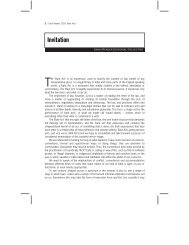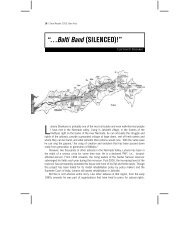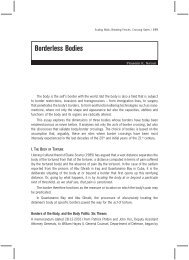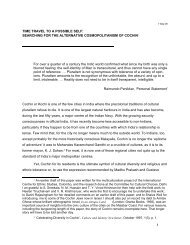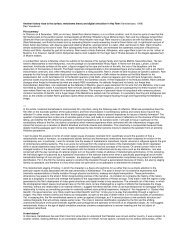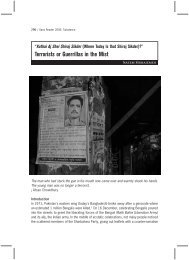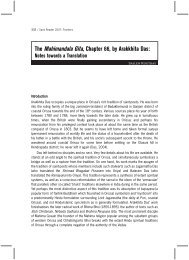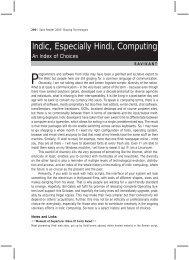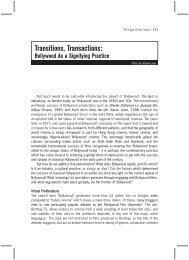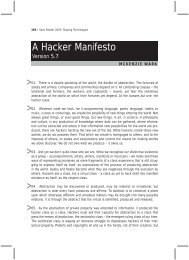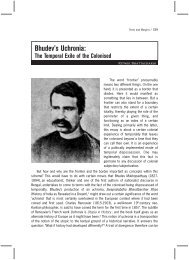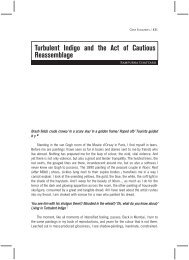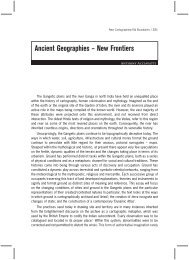Create successful ePaper yourself
Turn your PDF publications into a flip-book with our unique Google optimized e-Paper software.
258 / <strong>Sarai</strong> Reader 08 : <str<strong>on</strong>g>Fear</str<strong>on</strong>g><br />
masculine prowess in subduing the m<strong>on</strong>ster and re-establishing harm<strong>on</strong>y where there was<br />
<strong>on</strong>ce chaos. Therefore, in an unprecedented move for a horror film, Purana Mandir ends not<br />
with the bruised dyad but with a happy trio: boy, girl and girl’s father. “I’m really proud of you,<br />
my s<strong>on</strong>”, the Thakur sniffs. The ‘Purana Mandir’ of horror literally modulates into the mandir<br />
(temple) of the marriage cerem<strong>on</strong>y as Sanjay and Suman are wed and ‘The End’ is hurriedly<br />
ushered in.<br />
Inescapable here is the clunkiness of the Ramsay Brothers who, with their limited budgets<br />
and talents, <strong>on</strong>ly occasi<strong>on</strong>ally realised their ambiti<strong>on</strong>s. The frenetic camera movement of<br />
some sequences in Purana Mandir bears resemblance to the innovative cinematography<br />
in Evil Dead (Sam Raimi, 1981); the baroque, taxidermically-inclined space of the haveli<br />
recalls The Haunting (Robert Wise, 1963) or any number of Hammer films; the extremely<br />
tight compositi<strong>on</strong> into which something (a cat, a crazy woman) suddenly emerges to scare<br />
the living daylights out of Suman suggests Halloween (John Carpenter, 1978); the coffin<br />
and horse-drawn carriage are straight out of numerous Stoker adaptati<strong>on</strong>s; there are pointof-view<br />
shots that are akin to shots from Black Christmas (Bob Clark, 1974), as well as the<br />
Romero-style gait of the possessed man-servant. For the most part, though, these moments<br />
of ‘horror’ play out as incompetent hack-jobs and incomplete masteries. Night-time shooting<br />
was still a problem for the Ramsays, and Purana Mandir would have additi<strong>on</strong>ally called for a<br />
fairly complex choreography of darkness and lighting, silence <strong>on</strong> set and post-sync sound,<br />
not to menti<strong>on</strong> a small army of technicians working with prosthetics, make-up, fog machines<br />
and other ‘special effects’. It remains unclear what degrees of expertise were involved, given<br />
the general sense of workshop-improvisati<strong>on</strong> prevailing with the family.<br />
Where, then, does the horror inhere in a Ramsay film? The genre’s c<strong>on</strong>venti<strong>on</strong>s, forced into<br />
visibility by the yawning gap between aspirati<strong>on</strong> and accomplishment – when the make-up<br />
is under-baked, or the camera doesn’t move nearly fast enough, or when the cat looks less<br />
like it’s jumping into the frame and more like it’s being chucked into it by a spotboy – can<br />
be moments of unintenti<strong>on</strong>al hilarity, as globally circulating ‘signs’ of horror are shriveled to<br />
an embarrassingly inchoate generic language that cannot c<strong>on</strong>ceal its own manufacturedness.<br />
These moments can also, however, cause shudders, involuntary recoils at the<br />
excessive materiality of the image; the Ramsay films often gain in stature as a result of<br />
this unexpected effect. Terror here is less a matter of slick technical virtuosity and more a<br />
matter of something earthy and visceral. The vampire-overlord<br />
in Bandh Darwaza (Closed Door, 1990) has n<strong>on</strong>e of the ethereal,<br />
otherworldly quality of the early sound phase or the Hammer<br />
films; he is an affective, if inelegantly prosthetic m<strong>on</strong>ster. In Aur<br />
Kaun (Who Else, 1979), the corpse of a murdered woman rots<br />
in a refrigerator and is eventually sunk in a lake. The texture of<br />
every Ramsay film is heavy with the smell of bodies – the dread<br />
of corporeal finitude played out in a mise-en-scène of involute<br />
caves and subterranean dwellings.



